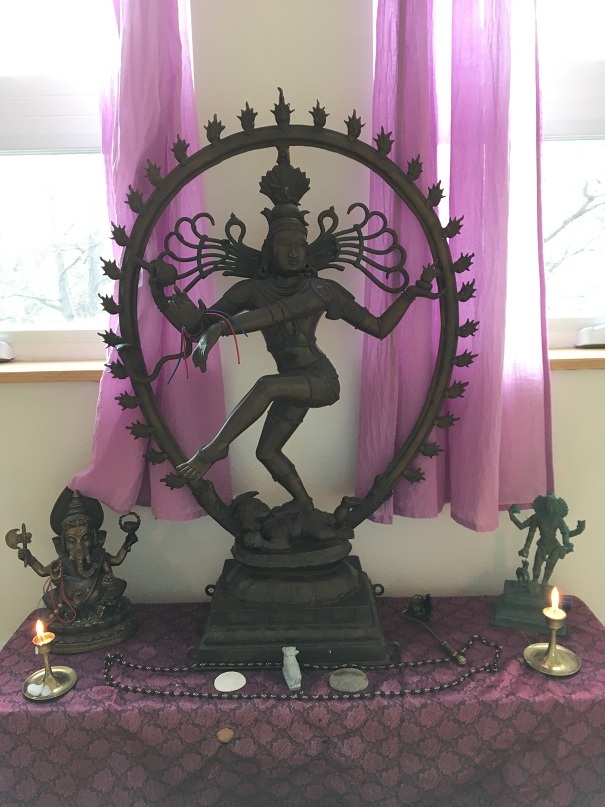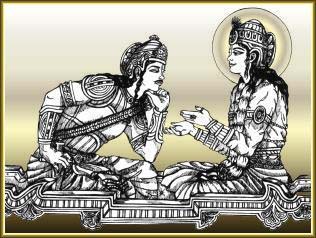You may know that the first word of any text is said to be of special significance and reflects the highest first. In the case of the Bhagavad Gītā, the first phrase is “dharmakṣetre,” the “field of dharma,” referring to the field on which the battle is taking place. It represents our lives in its many levels and domains, where all the challenges we face in the course of a lifetime play out. So in a sense, the entire conversation between Kṛṣṇa and Arjuna is about how to live our dharma in all the many facets of our lives.
“Dharma” is often translated as “sacred duty, law, or righteousness.” It comes from the verbal root “dhṛ:” “to hold, make firm, nurture and sustain.” Dharma can be thought of as that which sustains or holds things together. It also carries connotations of ethics, justice, goodness, and virtue. There is really no one great English word that captures the nuance of the concept of dharma.
“Kṣetra” literally means “field.” At the level of your individuality, this can be thought of as your field of awareness. So dharma-kṣetra is your individual consciousness, it is where we grapple with our dharma, which is exactly what Arjuna is doing in the Bhagavad Gītā, with the help of Kṛṣṇa. On the battlefield are two opposing sides, one of which is considered more righteous, or dharmic, than the other. The war has come about in order to restore dharma/righteousness. And metaphorically we have parts of ourselves struggling with what is dharmic in our many life situations.
We can also think of the field in a larger way, as any domain in which we operate, where we live our lives. This could be our family, our spiritual community, our professional field, or society at large. This concept, in particular, applies not only to our individual lives but also to upholding and nurturing society as a whole. Dharma is what sustains society. It is that which is uplifting and leads to the greatest collective good. The Bhagavad Gītā challenges us, from its very beginning, to consider deeply how our actions align with righteousness, and how we uphold righteousness in a misaligned world.
Arjuna and Kṛṣṇa are standing on the field of dharma, and metaphorically, these characters are two parts of ourselves, and the field is the inner topography of our consciousness. Arjuna is experiencing a battle within himself, trying to understand what his duty is, what will hold things together, create alignment and serve the highest. And for each of us, as embodied beings, the whole world is our dharma-kṣetra, the field on which we discover and enact our dharma, minute-by-minute, day-by-day, year-by-year.
During their conversation in the Bhagavad Gītā, Kṛṣṇa refers to Arjuna’s “svadharma.” “Sva” means “self,” so svadharma is your own particular dharma. Your own duty. In more modern times, svadharma has been described as your purpose. What are you here to do to create greater alignment within yourself and in the world? How are you helping to hold things together?
Kṛṣṇa reminds Arjuna that his svadharma is that of a warrior (e.g., 2.31, 2.33). In the context of this story, Arjuna’s dharma is to uphold righteousness in society through his actions as a warrior. The whole premise of the Bhagavad Gītā is Arjuna questioning this, as he is not happy about facing an opposing army comprised of people he is connected with. But the concept of dharma dictates that upholding society requires him to do his duty as a warrior.
He has received a great deal of privilege, being part of a lineage of nobility, but with it comes certain responsibilities. Yet he must make it truly his own, so he is not doing what someone else thinks is his dharma. In the course of the conversation, Arjuna is coming to understand his sva-dharma, his own dharma.
In many societies, even today, there are fairly strict roles, so this teaching could be challenged when it is taken to oppress or “keep people in their place.” For example, women in societies where their role is traditionally restricted, are extremely challenged to live their own dharma. They may have to confront societal prescriptions to enact what is truly their svadharma, in terms of what is more nurturing and sustainable.
Our modern society seems to have so much freedom, so many options, that it can be overwhelming to understand what is most dharmic. That’s why the yogic practices are so important for us in our modern lives, to connect to our essence as a guide, our Kṛṣṇa self, so we can each discover our gifts and become clear on what is dharmic in each situation and our lifetime as a whole.
Dharma operates on all levels of our life simultaneously. Throughout the text of the Bhagavad Gītā, we learn that yoga is not about becoming a renunciate, withdrawing from our familial and societal duties and responsibilities. Instead, dharma is about being actively present to the opportunities life presents for sustaining the world, for upholding dharma in society and nature, as well as in our inner growth, what nurtures us individually, and what connects us to our highest purpose.
In his commentary on the first verse of the Bhagavad Gītā, the great Tantric sage Abhinavagupta cites a text that says the highest dharma consists of the realization of the Self by means of yoga. Abhinavagupta is saying that to be dharmic we start with one’s self, refining ourselves through our practice of yoga, which aligns us with the highest. Then we spontaneously are pulled to create alignment on societal and global levels. Because when we do our practices and begin to realize our Heartself, our essence, we begin to see the connection of all things, and quite naturally our actions begin to unfold in a way that reflects dharma in all of our activities.
As Kṛṣṇa reminds us throughout the text, each of our actions is an opportunity to assert dharma. Sometimes it is fulfilling the duty of one of our roles in life, be it, for example, warrior, teacher, spouse, parent, etc. Sometimes it is about making the best choice in a challenging situation, which perhaps we would prefer to avoid altogether. Sometimes it is about remembering what we uniquely have to offer in a given situation, our own dharma/svadharma. And as Abhinavagupta reminds us, sometimes dharma is about doing what aligns us with our highest Self.
As Kṛṣṇa makes clear, ultimately to create dharma in the world, we must act. We must consider how every decision, every action contributes toward sustaining the righteous integrity of our connection with our innermost selves. And as well our actions should help sustain and hold together our society and the planet in the highest possible way.
CONTEMPLATE, PRACTICE, and JOURNAL:
Contemplate the idea of dharma on its many levels. Consider your duty in society, to your individual self, and to your highest self. Think of experiences/examples when you faced a conflict like Arjuna wherein your individual desires conflict with what is best for society. What does dharma mean in these different contexts?
Consider dharma as what holds things together. How does this relate to your yoga practices, especially meditation?
What do you make of the term “svadharma”? What does it mean for you?
Keeping in mind your definition of dharma, how is it reflected (or not) in your actions? For some period of time, mindfully consider whether each of your actions is dharmic.




